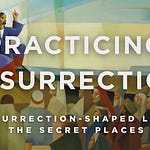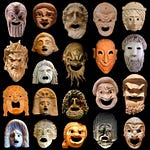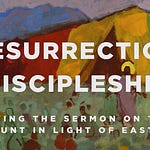Genesis 1:26-31
Psalm 139:13-16
Easter 2
In the aftermath of Easter Sunday, after the brass and timpani have been packed away, after the flowers are gone, and after we have had a moment to catch our breath, we can find ourselves unsure of what to do next. We proclaimed Jesus Christ resurrected; now what? We declared in word, song, and sacrament that the power of Sin and Death was overcome when a crucified messiah left his burial clothes behind, and now we are supposed to return to life as usual?
Are we to go about our days as though nothing happened last Sunday? As though nothing happened in Jesus’s borrowed tomb two thousand years ago?
I am firing off a lot of questions at you, but these are the questions that have been running through my mind since Monday morning and I have to believe you may have asked yourself something similar.
What does it mean to live in the light of the resurrection? What does a resurrected life even mean?
The Church has wrestled with these questions ever since Mary first declared the tomb empty. The first disciples fled and hid in fear. Many of the early theologians of the Church navigated these questions, and we see in the Book of Acts that the early Church responded to the resurrection proclamation by gathering and sharing all that it had. In sharing all they had, they were not only sharing monetary possessions. Instead, Luke tells us, “Now the whole group of those who believed were of one heart and soul, and no one claimed private ownership of any possessions, but everything they owned was held in common. With great power, the apostles gave their testimony to the resurrection of the Lord Jesus, and great grace was upon them all.”[i]
“Of one heart and soul.”
They were a whole community, whole in that those in need were cared for. Their response to the Easter proclamation was to gather and navigate life together—the spiritual and physical aspects of life.
Were those first Christians perfect? Heck no! However, their care for one another's spiritual and physical needs provides the Church today with a guidepost as we follow Jesus.
One of the more modern responses to the Easter proclamation is not as modern as we would like to think. Skeptics and cynics alike ask for physical proof of Jesus’s resurrection. “Was Jesus’s bodily resurrection fact or fiction”? they ask. And in asking that question, our resurrection comes to light. Really, this question has been wrestled with since the first Easter declaration was made. Some went so far as to argue that Jesus was never physically a human. This not only negated the resurrection but called into question the incarnation altogether.
Concerns about the logistics, about how God did or did not do what God did, miss that God did something. Rev. Fleming Rutledge writes, “The crucifixion is the touchstone of Christian authenticity, the unique feature by which everything else, including the resurrection, is given its true significance. The resurrection is not a set piece. It is not an isolated demonstration of divine dazzlement. It is not to be detached from its abhorrent first act. The resurrection is, precisely, the vindication of a man who was crucified.”[ii] The resurrection is God’s vindication over the death we placed upon God.
Beginning today, we will consider what life looks like in light of the resurrection over six weeks, specifically, what a whole life looks like in light of the empty tomb.
The resurrection of Jesus Christ has implications for our whole selves – our bodies, minds, and souls.
Who we are—every part of our being—is wrapped up in being created in God's image and tied up in Christ's life, death, and resurrection.
From the beginning of humanity, we have been declared “good” by God. Do we always act “good?” Certainly not, but God called what God created, you, “good,” so you are good regardless of what you or others may say about you.
You are “good” regardless of your actual or perceived flaws.
You are “good” regardless of what others may say about you.
You are “good” regardless of what you say about yourself.
In a world that often demands that we filter ourselves through the lens of what popular culture demands, God says you are good to go. This is because we know that God loves you just as you are and that God loves you too much to leave you just as you are. When I say, “God loves you too much, leave you just as you are,” I am saying that God is making you more and more like Christ.
Is God making us into the Saviors of the world? No. We already have one of those and live our life, died our death, and in his resurrection, we find hope for not just eternity with God but for the fullness of physical life.
The promise of bodily resurrection is the continuation, a divine “Amen!” from the One who created us and declared us to be “good.”
Author Barbara Brown Taylor wrote, “What is saving my life now is the conviction that there is no spiritual treasure to be found apart from the bodily experiences of human life on earth. My life depends on engaging in the most ordinary physical activities with the most exquisite attention I can give them. My life depends on ignoring all touted distinctions between the secular and the sacred, the physical and the spiritual, the body and the soul. What is saving my life now is becoming more fully human, trusting that there is no way to God apart from real life in the real world.”[iii]
This life's physical and spiritual experiences are wrapped together. They are intricately intertwined.
Look, I get it. I know that when it comes to the resurrection and talk of the bodily resurrection promised to us by Jesus, many may scoff or cross their fingers during that part of the Easter proclamation.

Like Doubting Thomas, we need proof to believe. We need a body or DNA evidence. Doubting Thomas has received a bad reputation over the centuries because he is us. We want proof. We require proof of our Easter declaration.
At the same time, when God calls us and others “good,” we need proof because the world tries as it might to divide us into what author David Fitch calls the church of us versus them. We need proof that they are good. We may even need proof that we are good.
Who we are—God’s good creation—is reflected in the fullness of God. And all of us—the divine good and the bad we sometimes see and do—were wrapped up in Christ as he went to the cross. All of it walked out of the tomb on Easter.
There is an Old Testament prophet named Ezekiel. He had a vision of life returning to the driest of decayed bones and flesh.
“The hand of the Lord came upon me, and he brought me out by the spirit of the Lord and set me down in the middle of a valley; it was full of bones. He led me all around them; there were very many lying in the valley, and they were very dry. He said to me, ‘Mortal, can these bones live?’ I answered, ‘O Lord God, you know.’ Then he said to me, ‘Prophesy to these bones, and say to them: O dry bones, hear the word of the Lord. Thus says the Lord God to these bones: I will cause breath to enter you, and you shall live. I will lay sinews on you, and will cause flesh to come upon you, and cover you with skin, and put breath in you, and you shall live; and you shall know that I am the Lord.’”[iv]
God promises new life and resurrection in our lives where conventional wisdom says otherwise. God’s grace cuts through all of the reasons we say this cannot be and, through their need, our need for proof, invites us to live life in the light of the resurrection. The good news is that this promise holds whether we proclaim the mystery of faith without crossing our fingers or if we, like Thomas, need to touch the resurrected body of Christ.

Jesus did not leave us without the resurrected body to touch. He has given us the proof we need – as Christ’s body, the Church is the proof of the promised resurrection. And if that is not enough, we have bread and cup – a meal through which Christ promises to be with us and transform us from the inside out.
[i] Acts 4:32-33, NRSV
[ii] Fleming Rutledge, The Crucifixion: Understanding the Death of Jesus Christ
[iii] Barbara Brown Taylor, An Altar in the World: A Geography of Faith
[iv] Ezekiel 37:1-6


















Share this post